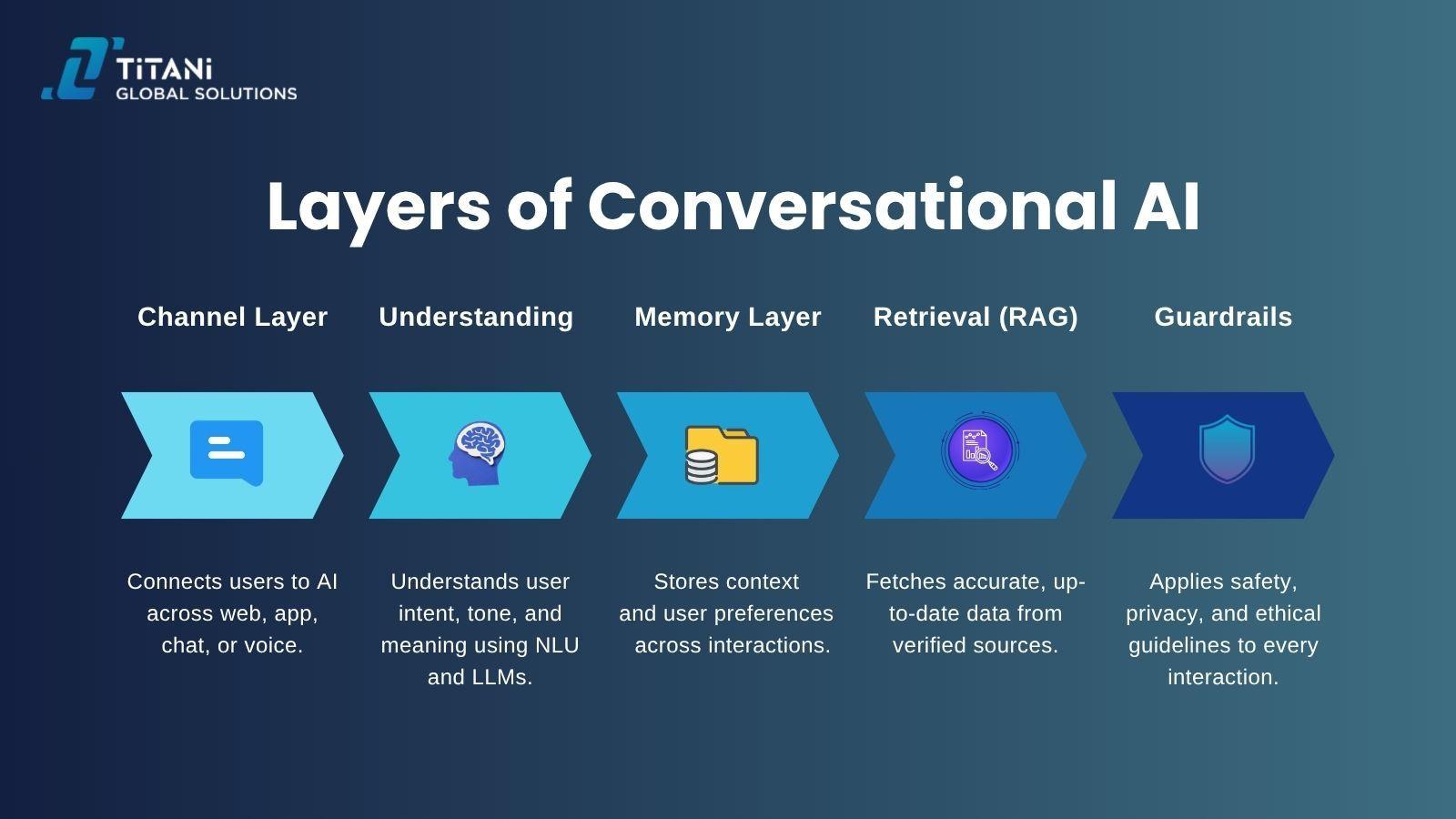Summary
Conversational AI is transforming enterprise communication — moving from scripted automation to intelligent systems that listen, remember, and respond with empathy.
Human-centered design combines empathy and clarity to make digital conversations feel authentic while improving trust, engagement, and customer satisfaction.
Intelligent dialogue relies on three core dimensions — Intent, Emotion, and Action — turning every exchange into measurable business value.
A five-layer architecture (Channel, NLU/LLM, Memory, RAG, Guardrails) enables accuracy, continuity, and compliance across all interactions.
Successful enterprises measure impact through CSAT, FCR, AHT, and Containment Rate, supported by transparent governance under frameworks like NIST AI RMF and the EU AI Act.
Conversational AI is no longer about replacing people — it’s about amplifying human understanding and building lasting trust at scale. yu

Most enterprises already use chatbots, yet too often these so-called “AI assistants” end up frustrating customers instead of helping them.
We’ve all experienced it. The words make sense, but the exchange feels mechanical. There is no empathy, no memory, no trust. It’s not a conversation — it’s a transaction that leaves users colder than before.
That is the pain point modern organizations are urgently trying to fix. They are no longer asking “Should we use AI?” but “How can AI make every digital interaction feel more human and more valuable?”
This is where intelligent conversational AI changes the game. It moves beyond static scripts into dynamic systems that listen, remember, and respond with empathy, creating experiences that connect people, data, and decisions in real time.
At Titani Global Solutions, we call this shift the human side of intelligent conversations — AI that does not just reply but truly understands the customer behind the screen.
What Does “Talk to AI” Really Mean?
To talk to AI is not just about getting an answer. It is about being understood.
When people reach out to a virtual assistant, they are rarely asking for information alone. They are sharing a need, a moment of frustration, or a question that truly matters to them. The real goal is not speed, it is understanding.
A good AI does not just respond. It listens between the lines. It remembers context, senses tone, and adapts the conversation so the user feels seen, not processed. That is the difference between a system that simply reacts and one that genuinely communicates.
Imagine a customer asking about a delayed order. A basic chatbot might quote the delivery policy. But an intelligent assistant checks the purchase history, acknowledges the inconvenience, and reassures the customer with an update that feels personal. The result is not just a solved ticket; it is a restored sense of trust.
At Titani Global Solutions, this is what talking to AI truly means: using technology to bring empathy and clarity into every interaction. When language, data, and design work together, AI becomes more than a tool; it becomes part of how your business listens.
The Human Side of Intelligent Conversations
Behind every AI interaction lies a simple human expectation—to be heard and understood.
Yet, so many digital systems still lack that emotional awareness. When digital interactions feel detached, customers feel abandoned. Research from PwC shows that 59% of consumers believe companies have lost touch with the human element of customer experience. Conversely, when digital interactions feel personal and emotionally aware, satisfaction can rise by more than 20%.
True conversation design starts with empathy. Users rarely remember the exact words a system uses; they remember the feeling the exchange produced—whether they felt supported, respected, or dismissed.
Consider the healthcare sector: A traditional chatbot may simply list appointment slots. A conversational AI assistant, however, detects urgency, proactively offers an earlier option, and sends a gentle reminder before the visit. The process remains digital, but the interaction feels inherently human.
At Titani, we design AI systems that blend empathy with clarity. When every message sounds natural and transparent, users feel guided rather than managed—turning mere automation into lasting trust.
Designing Conversations That Drive Outcomes
Every effective conversation, whether human or digital, requires structure. For AI systems, that structure is built on three critical dimensions: intent, emotion, and action.
These layers are what separate basic, scripted chatbots from intelligent assistants that actively solve problems and create measurable results.
1. Intent: Understanding What Users Truly Mean
Great AI systems interpret the user’s ultimate goal, not just the keywords they speak. Instead of reacting to isolated terms like “refund” or “delivery,” intelligent assistants read the full context to anticipate the real need. This dramatically reduces misrouted tickets and slashes resolution time.
2. Emotion: Responding with Empathy
Emotion determines how users perceive your automation. By detecting tone and frustration, AI can dynamically shift its language from neutral to reassuring, or even apologetic. Empathetic responses significantly lower customer stress and strengthen loyalty—a critical driver for long-term retention.
3. Driving Action
A good conversation must end with resolution. AI must be enabled to act, not just inform—whether that means instantly updating a record, confirming an appointment, or intelligently escalating complex issues to a live agent with a full, comprehensive context log.
When intent, emotion, and action work together, conversations cease to be transactions. They become meaningful exchanges that build trust and deliver measurable business impact—from higher CSAT scores and faster resolution, to lower operational costs.
The Engine of Empathy: The Multi-Layer Architecture of Conversational AI
When customers talk to AI, the experience often feels effortless — a seamless exchange where technology understands, responds, and resolves with precision. Yet behind this apparent simplicity lies a carefully orchestrated architecture that mirrors how humans communicate.
This architecture is composed of five interconnected layers, each designed to integrate intelligence, empathy, and responsible governance.

1. Channel Layer: Where Every Dialogue Begins
This is the front line of user engagement. The channel layer connects every touchpoint from websites and mobile apps to WhatsApp or voice assistants—ensuring an absolutely consistent experience across all platforms.
Imagine a customer starts a chat on the website, then seamlessly continues the exact conversation on WhatsApp while heading to the airport. The AI instantly recalls context, tone, and recent updates, allowing the dialogue to continue naturally, without frustrating repetition.
Business Value: Consistency is the first language of trust. A seamless omnichannel experience strengthens engagement and reduces friction, helping customers feel recognized wherever they are.
2. Understanding Layer: Decoding Meaning, Not Just Words
At the core of conversational AI lies understanding — the ability to move beyond keywords into true comprehension. This is where Natural Language Understanding (NLU) and Large Language Models (LLMs) come together.
NLU breaks language into structure, while LLMs add context, nuance, and emotion. Together, they enable AI to interpret intent, extract entities, detect tone, and even anticipate next steps.
In enterprise environments, this layer transforms raw text into actionable understanding. Integrated with CRMs, knowledge bases, and domain-specific datasets, it allows responses that feel contextual and human.
Example: A user types, "I’m not sure this plan fits my needs." A rule-based bot assumes cancellation. An intelligent conversational AI recognizes uncertainty and responds, "Would you like to see other plans that might suit you better?"
Business Value: Better comprehension leads to faster resolution, fewer errors, and deeper customer trust.
3. Memory Layer: Remembering with Responsibility
Every meaningful conversation depends on memory. In AI systems, the memory layer ensures that context, intent, and user preferences persist — allowing the system to respond as if it truly “remembers.”
There are two complementary dimensions:
Short-term memory holds session context, ensuring flow within a single interaction (“As we discussed earlier, your order has shipped”).
Long-term memory captures anonymized patterns across sessions, allowing AI to anticipate preferences and personalize at scale.
But memory must be balanced with responsibility. Under regulations like GDPR and ISO 27001, AI must remember what adds value — and forget what compromises privacy. Designing systems that “remember with reason” is a cornerstone of ethical AI.
Example: A returning customer reopens a chat about a shipment issue. The AI instantly recalls the previous ticket, retrieves the current order status, and responds: “Your parcel left the warehouse this morning and is now in transit.”
The Takeaway: Memory makes AI feel attentive. Responsible memory makes it trustworthy.
4. Retrieval Layer (RAG) — Grounding Answers in Real Data
Understanding language is only half the equation; ensuring factual accuracy completes it. The retrieval layer, powered by Retrieval-Augmented Generation (RAG), anchors AI responses in verified company knowledge.
Before generating an answer, the AI retrieves relevant data from internal systems — product databases, service manuals, or policy documents — ensuring that outputs are both contextually relevant and factually correct.
Business Value: Grounded responses eliminate misinformation (hallucinations) and build confidence. Enterprises implementing RAG report up to 40% fewer AI inaccuracies and significantly faster response generation.
5. Guardrail Layer: Securing Every Conversation
This layer defines what AI can and cannot say. It enforces Responsible AI principles and ensures regulatory compliance through frameworks such as the NIST AI RMF and the EU AI Act.
It also guarantees data redaction, intelligent escalation to human agents when necessary, and full auditability—protecting both the enterprise and the end user.
Business Value: Safety is not a feature; it is the foundation that sustains long-term trust and regulatory integrity.
Where Empathy Meets Engineering: The Titani Approach
At Titani, we engineer conversational ecosystems that seamlessly connect empathy with technical excellence. Our architecture blends LLMs, RAG, and secure guardrails, built under ISO 27001 compliance, to ensure accuracy, transparency, and data security across every interaction.
This is how we transform AI communication from reactive automation into a living system that understands, adapts, and grows with your business.
The Big Picture: When All Layers Work in Harmony
When these five layers—channel, understanding, memory, retrieval, and guardrails—operate as a unified whole, conversations evolve from mechanical exchanges into intelligent, human-centered experiences.
Customers gain faster, more personal, and more secure interactions.
Enterprises gain measurable value—reduced support costs, stronger brand trust, and scalable customer satisfaction.
At Titani, we believe this harmony between intelligence and empathy defines the future of enterprise AI communication.
Keeping Conversations Human and Consistent
Artificial intelligence may automate the mechanics of conversation, but it is the human element that ultimately defines its impact.
Enterprises that succeed with conversational AI understand one truth: meaningful interactions rely on three core pillars—consistency, tone, and collaboration.
When these three factors align, every exchange feels natural, trustworthy, and unmistakably humane.
Consistency: Building Continuity and Confidence
Modern users no longer experience brands through isolated channels.
They expect one continuous dialogue that flows naturally from website to app, and from chatbot to a human agent, without losing context or clarity.
For enterprises, achieving this fluidity means building an omnichannel infrastructure where every interaction is remembered and intelligently connected. The AI must recall prior context—recent purchases, service preferences, or past concerns—while strictly respecting privacy boundaries.
This is more than mere convenience; it is trust-building at scale. When customers sense that a brand remembers who they are and what matters to them, the relationship deepens.
Real-World Example: Global logistics providers like DHL Express integrate AI-powered chat across the web, app, and WhatsApp Business to give customers real-time shipment updates. The assistant remembers tracking context, eliminating redundant steps and ensuring continuity even when users switch devices.
Business Impact: Consistency in communication drastically reduces customer effort, strengthens retention, and transforms automation into a seamless, positive brand experience.
Tone: Translating Brand Personality into Every Response
Tone is what makes technology sound alive.
It is the emotional bridge between a company’s values and the user’s expectations. Every brand has a unique language—a financial institution should project precision and reassurance; a wellness platform must sound calm and supportive; a retail brand thrives on friendliness and optimism.
In conversational AI, tone design involves calibrating the language, pacing, and even sentence length to mirror how the brand would speak if it were a person. Critically, it requires emotional sensitivity—recognizing frustration, uncertainty, or satisfaction, and responding appropriately.
Real-World Example: A healthcare assistant built on AI can respond to anxious patients using clear and comforting language—not robotic phrases. By acknowledging emotion (“It’s understandable to feel uncertain about results”), tone becomes care in action.
Business Impact: A consistent, emotionally aware tone of voice strengthens brand integrity, increases engagement, and significantly improves satisfaction across all digital touchpoints.
Collaboration: Balancing Automation with Human Empathy
AI can effectively streamline processes, but empathy remains a uniquely human capability.
The most effective conversational systems recognize precisely when to step aside and hand over control to people. This handoff is not a sign of failure—it is the hallmark of intelligent design.
When escalation happens, the system passes along complete context—user history, sentiment, and key details—so that the human agent can continue the conversation without interruption.
In industries like banking and insurance, AI handles up to 80 percent of standard requests. Yet, when emotion, judgment, or negotiation enter the equation, the conversation transitions smoothly to a person who already has full context displayed on their screen. The result is a faster, more compassionate resolution.
Business Impact: Collaboration between AI and human agents preserves essential empathy while drastically improving service speed and quality. It transforms automation from a cost-saving mechanism into a relationship-building tool.
Human Connection at the Core
Technology can scale communication, but only thoughtful design can sustain trust.
Enterprises that balance consistency, tone, and collaboration are not just automating workflows—they are actively shaping relationships. As Deloitte Digital highlights, organizations that design for human experience outperform peers with twice the customer engagement and significantly higher loyalty.
At Titani Global Solutions, we believe the future of AI communication lies in amplifying human understanding, not replacing it. Consistency keeps conversations connected, tone keeps them personal, and collaboration keeps them alive. Together, they form the foundation of truly intelligent conversations.
Measuring Success and Earning Trust in AI Conversations
Human-centered AI isn't just about creating natural dialogue; it’s about proving measurable business value. To achieve this, organizations must combine two critical elements: a clear measurement framework and a culture of responsible design.
Measuring What Matters
Every intelligent conversation must create tangible results. Forward-thinking enterprises measure performance through key indicators such as Customer Satisfaction (CSAT), Containment Rate, Average Handling Time (AHT), and First Contact Resolution (FCR). These metrics reflect both the quality of the user experience and the operational efficiency of automation.
Across enterprise deployments, well-designed conversational AI has been shown to reduce AHT by 25–40%, while simultaneously boosting CSAT by 15–20%.
At Titani Global Solutions, our pilot programs consistently demonstrate ROI within the first 12 weeks of deployment, driven by improved containment rates and smoother agent collaboration.
The most effective AI initiatives always begin with a Conversation Audit—a structured review that identifies friction points, benchmarks current performance, and guides continuous improvement through data rather than assumptions.
Trust as the True ROI
Performance metrics prove the value of automation, but trust determines how long that value lasts.
As enterprises scale their conversational AI systems, strong governance ensures every interaction remains secure, transparent, and compliant.
Frameworks such as the NIST AI Risk Management Framework and the EU AI Act provide the foundation for responsible deployment. They define how data is used, how bias is minimized, and how accountability is maintained across teams.
Transparency is equally vital. AI should always make its role clear, outline what it can and cannot do, and seamlessly hand over to human agents when necessary. Pretending to be human may capture attention for a moment, but openness builds loyalty that endures.
When measurement and governance operate together, enterprises deliver what modern users value most: efficiency that feels human, and innovation that inspires trust.
In the long run, trust becomes the most important metric of all — it drives engagement, sustains loyalty, and protects brand reputation in the era of intelligent automation.
Conclusion: The Future of Conversational Advantage
The future of conversational AI is not about replacement; it is about enrichment. Intelligent dialogue bridges technology and humanity, combining the speed of machines with the empathy and intuition of people.
For enterprises, meaningful AI conversations start where value is clear and measurable. Customer service, onboarding, and internal support are ideal entry points — they deliver visible results and show how automation enhances responsiveness while freeing human teams for creativity and care.
As organizations mature, conversational AI evolves from a support tool into a growth engine that strengthens relationships and builds trust. When designed responsibly, talking to AI becomes more than a transaction; it becomes an ongoing exchange that reflects a company’s values in every interaction.
At Titani Global Solutions, we believe the most intelligent systems are those that bring people closer together. Our approach blends empathy with engineering to create AI that listens, learns, and delivers measurable business outcomes.
Ready to explore how conversational AI can transform your enterprise communication.
Connect with our experts at Titani to discuss your goals and discover how human-centric AI can elevate both customer and employee experiences.



